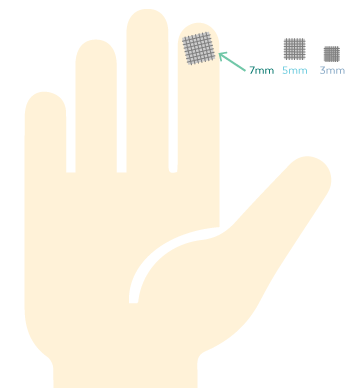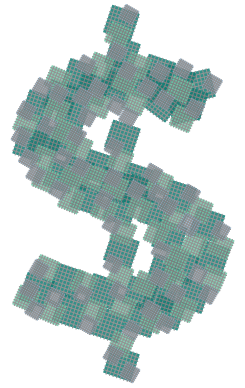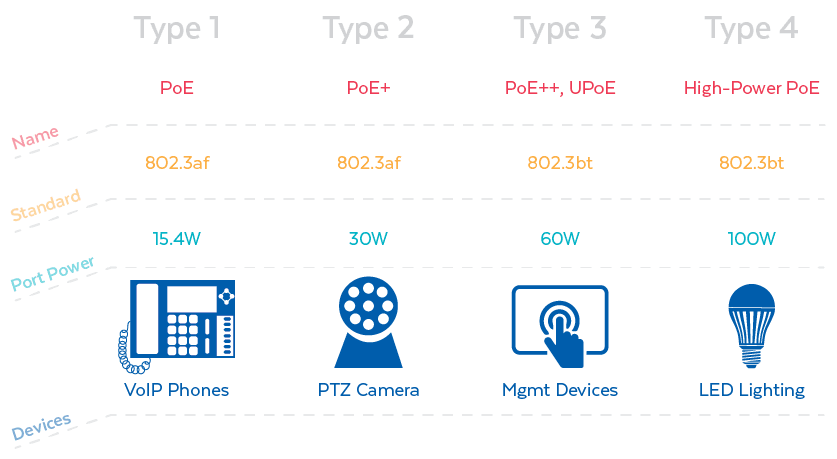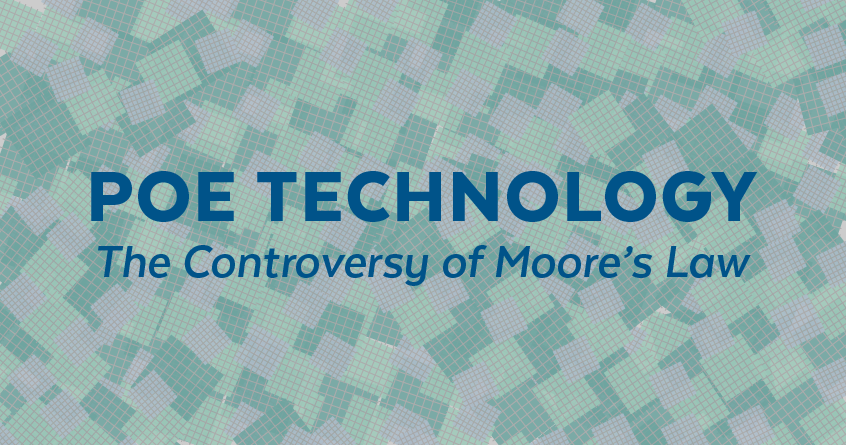In 1965, Gordon Moore published his ideas on “Cramming More Components onto Integrated Circuits,” focusing on reducing the cost per component for a single circuit. Moore predicted that the cost per component would decrease as miniaturization technology advanced. Moore’s Law, which originated from this article, states that the number of transistors on a circuit will double every two years without an equivalent increase in cost. Fast forward to today when the importance of cost reduction is every bit as vital to business, the implications of Moore’s law in PoE technology are worth examining.
Three years after publishing the article, in 1968, Moore co-founded Integrated Electronics, better known as Intel. His firsthand observation of the exponential growth of microprocessor technology became Intel’s guiding force. Moore’s experience propelled Intel to become the world’s largest chip manufacturer in 1991. Historically, Moore’s Law was never actually a law. It was a mission statement, a company goal, and eventually a mantra.
Moore’s Law quickly became part of Intel’s culture. In 2021, Pat Gelsinger (Intel’s CEO) announced that Intel planned to uphold Moore’s Law for another ten years. While some within the industry sided with Gelsinger, not everyone agrees that Moore’s Law will survive another ten years. Hence, the controversy.
Declining Returns of Moore’s Law
Computational speed comes from electrons moving through transistors. It is finite, limited by how fast an electron can move through matter. Placing more transistors on a chip increases the total computational speed. However, miniaturization has limits. The smaller the chip, the higher the resistance. The higher the resistance, the lower the capacity.
According to Robert Colwell, the creation of the seven-nanometer chip in 2020 was the last iteration of process technology. Although companies may push to achieve a five-nanometer chip, it’s unlikely to significantly change the capabilities of the 2020 version. The manufacturing cost of a seven-nanometer chip is around $300 million, and over $500 million would be needed to produce a five-nanometer chip. Given the difference in cost, companies may not see the benefit of using a five-nanometer chip given the price.
Resistance increases as the chip size shrinks. At some point, current cooling technologies will be insufficient for effectively dissipating the chip’s heat. In the same way, energy costs will make per-component expenditures cost-prohibitive. For those who predict the end of Moore’s Law, the laws of physics and diminishing economic returns will eventually dictate when the law becomes obsolete.
Recasting Moore’s Law
Those who see Moore’s Law as alive and well in the 21st century look beyond its literal meaning. According to Mario Morales, a program vice president at IDC, Moore’s Law is about computing:
“We’re seeing an explosion of more computing across the entire landscape. It used to be computing was centered around mainframes, and then it became clients and now edge and endpoints, but they’re getting more intelligent, and now they’re doing AI inferencing, and you need computing to do that. So, Moore’s Law has been able to continue to push computing to the outer edge.”
Like Morales, many see Moore’s law as a driver of innovation. For example, we may not see a doubling of computing power every two years. These leaps in technology can have other causes besides the number of transistors. It could be a change in packaging that delivers improved capacity. Instead of relying on a single circuit, clusters of circuits could be made to work together to increase processor speeds. Whatever pushes the technology forward, businesses will always be looking for ways to increase their computing power. 
Applying the Essence of Moore’s Law to Power over Ethernet Technology
It’s easy to forget that, in the end, Moore’s Law was all about cost. As a businessman, Moore was most interested in the price of such exponential growth. Today, businesses are still struggling to balance the cost of innovation against the increasing need for computing power. As AI applications become more ubiquitous, companies must deploy intelligent devices at the edge connected to a network with enough capacity to acquire and process massive amounts of data.
In their search for more cost-effective computing power, organizations are leveraging existing Ethernet technologies such as Power-over-Ethernet (PoE) to build networks that support AI applications. PoE supports such efforts by enabling the transmission of both power and data over a single Ethernet cable without an added power source.
PoE Technology Standards
PoE is a relatively new technology. In 2003, IEEE published its 802.3af standard for PoE. It defined how a Category 3 Ethernet cable could deliver 15.4 W of power and transmit data at 10 Mbps. In 2009, the 802.3at standard was published. It increased power to 30 W over Category 5 Ethernet cables and supported data transmission speeds of 100 Mbps.
In 2018, IEEE published its 802.3bt standard for PoE. The 802.3bt standard identified two power levels for devices. Type 3 devices could support up to 60 W, and Type 4 could power devices requiring up to 100 W. The technology could transmit data at 1000 Mbps. With the rapid growth in AI applications, PoE technology had to push existing boundaries to reach gigabit transmission rates. Today, PoE can support over 5 Gbps with Cat 5 or 6 Ethernet cables.
 Moore’s Law
Moore’s Law
PoE technology reflects the essence of Moore’s Law. It combines innovation and cost-effectiveness to deliver more computing capabilities. It’s not about the number of transistors or the physics controlling the movement of electrons through matter. It is about testing technology’s boundaries to deliver innovative solutions that can be adopted in the wild.
PoE solutions maintain backward compatibility to protect existing investments. They minimize the cost of delivering power to the network’s edge for a better return on investment (ROI). Yet the industry is focused on meeting future needs while ensuring that the implementation operates effectively. Delivering solutions that integrate seamlessly into any network emulates how each generation of microprocessors has enabled companies to continue improving their computing power.
Gordon Earle Moore passed away in March 2023 at 94 years old, leaving behind a legacy that changed the world.
Versa Technology
Versa Technology is the industry leader in PoE solutions. We are committed to fulfilling the essence of Moore’s Law through adoptable innovation. Contact us to discuss how PoE technology can improve your network operations.
Sources:
Moore, Gordon. “Cramming More Components onto Integrated Circuits,” Electronics, Volume 38, Number 8, April 19, 1965.

